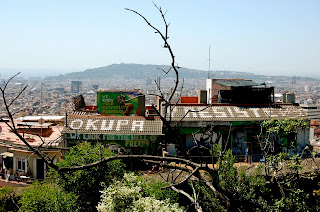
Although it was a bit of a hike and with more sun then we had experienced in Differdange, the Parc Guell designed by Antoni Gaudi was worth it. We started off by taking outdoor escalators up a very steep hill with only about a block of street that we had to walk, then we reached the dirt trail that lead us to not only was a perfect view of the city of Barcelona, but also a unique and fun looking architect plaza, church, and fountains. While everyone walked a head, I stayed back a bit and looked more at the houses and surrounding areas. I found this one house that had graffiti on it. What stood out to me about this building was not only that it was covered in graffiti, but that the statements were in English. They were all talking about capitalist, freedom, and justice, which was interesting because it was right off of a tourist trail. When I was there I didn’t really think much about the graffiti in English or trying to put it all together, but when I came back and started writing my blog, I decided to look up the two words in Spanish that I didn’t know, okupa y resiste, which is a alter-globalization movement called squatting that has been going on in Spain since the 60s. The movement started in Spain in the 60s as a result of scarce housing after movement from rural to urban areas. The action of squatting is a political activity that occupies abandoned buildings. This action, especially in Spain is an alter-globalization movement, looking at a different way of globalization and to serve more economic justice. After having learned this all and putting it together with the fact that this political group decides to place this squat right in the view of the trail for one of the major tourist spots in Barcelona, shows the geography of politics and the importance of placement. Another concept would be to look at the politics involved with globalization, I feel like the overall view of globalization is benefitting to everyone because people make profit off tourist and bigger industry, while these activist see it as a negative thing and want to look more towards human justice rather then profit. Without having any signs there would be little for a tourist to know about this building, I even took a picture not knowing what it was until later wondering why it was filled with graffiti. Especially since we were only in Barcelona for one full day, it makes it hard to experience small things like this when you are trying to jam in everything in a small amount of time and only hitting up the tourist attractions. It opened my eyes for future travels to look out more for things beyond the tourist attractions and what is listed on the map, that to be able to experience what a certain culture values and more then just what is in the books it will take a bit more observing and research either before or after you go.

http://en.academic.ru/dic.nsf/enwiki/216239
http://translate.google.com/translate?hl=en&sl=es&u=http://www.hartza.com/okupas3.htm&ei=AWgWTN72OtCZOIWRqa4M&sa=X&oi=translate&ct=result&resnum=8&ved=0CDEQ7gEwBw&prev=/search%3Fq%3Dokupa%2By%2Bresiste%26hl%3Den%26client%3Dsafari%26rls%3Den%26prmd%3Div
I really enjoyed your blog, it is always interesting to see the small things like the meaning of the words on the buildings that actually have a lot behind them. I never would have looked into what those Spanish words meant but I did notice in Spain especially Valencia the use of small details everywhere and symbols representing a variety of organizations ect. I saw a lot of vans with antiglobalization signs.
ReplyDelete